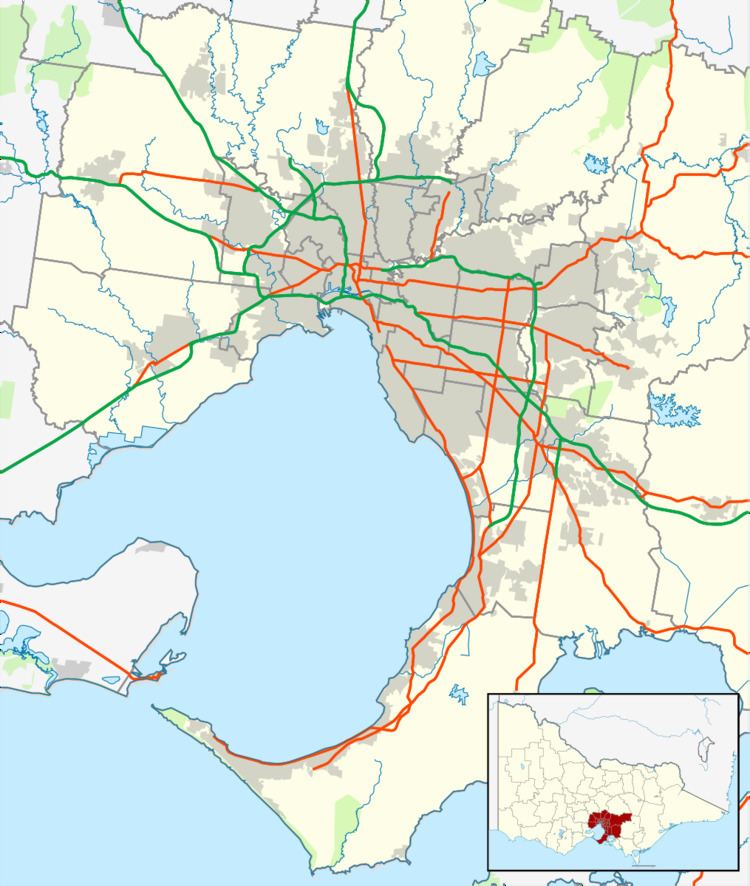Postcode(s) 3003 | Postal code 3003 | |
 | ||
Location 3 km (2 mi) from Melbourne | ||
Dudley Flats was a locality in Melbourne, Australia, in the 1920s–1950s, which supported a homeless camp during the Great Depression.
Contents
Location
It was located near the Melbourne docks beyond Dudley Street, south of Footscray Road, and on either side of the Moonee Ponds Creek. The area was formerly part of Batmans Swamp, a large saltwater lagoon, which by the mid 19th century had become fouled with effluent from the growing city.
Dudley Flats was on the fringe of the Melbourne city area, and became a dumping ground, with rubbish tips and a destructor established in the 1860s by the Melbourne City Council and Victorian Railways. The Melbourne Harbour Trust deposited dredged silt as part of land reclamation, and the railways tipped ash from locomotives at the North Melbourne Locomotive Depot from around 1888.
History
During the Great Depression of the 1930s (and also possibly from an earlier date), the site was visited and then occupied by Melbourne's poor and homeless who scavenged for scrap and rags from the tips, and built humpies out of discarded rubbish such as old timber and corrugated iron, even lino and hessian sacking. By 1935, over 60 humpies had been erected along the waterways and around the rubbish tips.
Despite regular raids by the police and possibly Harbour Trust officers, who attempted to move people out and demolish their huts, the area continued to be occupied at least up until World War II. The camps had been able to remain or be reestablished in part because of disputes between the various government bodies over who had authority, with the Railways Department, Melbourne City Council, the Melbourne Harbour Trust, the Board of Works, and the Lands Department, all refusing to claim responsibility for the area. Some of the residents were unemployed or underemployed labourers who occasionally gained work with shipping agents and stevedores at times of peak demands, but were otherwise left to scavenge an existence as best they could. The social reformer Frederick Oswald Barnett made several inspections of the congested residential areas of Melbourne's inner suburbs in 1933, including Dudley Mansions as the humpies were called. He photographed the slums and the residents' living conditions and recorded information on the residents' state of health, income, and where they obtained work (if at all). This material contributed to reports on slum conditions which eventually pressured the government into passing the Housing Act of 1937.
Structure of the camps
There were several separate camps in the area identified by Bamett and Edgar Thomas Wood, the Melbourne City Council health inspector from 1910 to 1949. Dudley Flats proper was located south of Footscray Road on the banks of the Coal Canal – constructed in the 1880s as an outlet for Moonee Ponds Creek, and to allow barges to unload coal at the locomotive depot. The 'Batchelor Quarters' were located on the north side of Dudley Street near a bridge over the canal, while 'Happy Valley' was on the east side of the canal. Residents were given notice of eviction in 1938, but nothing seems to have been done to remove them. The Melbourne City Council hosted a conference of the authorities responsible, which resolved unanimously: that the shacks and their occupants on areas of land at West Melbourne controlled by the Lands Department, Harbour Trust and Railways Dept, constitute a nuisance and should, in the occupants' interests, the interests of the community, and for health reasons, be removed therefrom ... the Conference recommends that the Departments concerned be asked to give the occupants notice to vacate the area within one month, and, on vacation, to have the structures entirely demolished. A little later council resolved to instruct the town clerk (Mr. H. S. Wootton) to discuss the matter with the Lands Department with a view ... to serve notices to quit on the Inhabitants, and to house them in charitable homes.
According to Council files, the settlement was abandoned in the early 1940s, because the nearby tips no longer held a living for scavengers after waste recovery schemes had been initiated to assist in the war effort.
Official settlement in the area seems to have involved only the occasional watchman at the nearby wharves. For example, Clement F. Harvey is recorded as living beside the Railway Canal on the North Side of Dudley Street West Melbourne in the Sands and McDougall Post Office Directory for 1929. However, the unofficial, and possibly illegal occupation of Dudley Flats was not recorded in the normal official sources.
Jack Peacock, a salvage dealer, was popularly known as the 'King of Dudley Flats' and was the flats' longest resident, having arrived in about 1932 and remained until the early 1950s, insisting on his rights to remain, claiming he had money enough to support himself and This life suits me and it is only the mental weaklings who desire to remove me. Men of education would allow me to remain."
Later history
In 1987, 60 demonstrators constructed a shanty town near Footscray Road to protest the lack of public housing.
Archaeological excavations in 1999 for the City Link Freeway exposed thousands of bottles and other rubbish from the tips, but it was not possible to distinguish remains of the settlement (which was built of tip rubbish on top of tip rubbish and eventually buried in tip rubbish).
Depictions in art and literature
Dudley Flats was a popular subject for painters from the late nineteenth century to about 1950, possbily in part because of the picturesque qualities created by wasteland and fringe settlements. These works included:
Reference in literature or quotes from literary figures relating to Dudley Flats are also common in the second half of the twentieth century:
In 2006, Sharon Thorn completed a PhD thesis on the artistic possibilities in fringe life.
